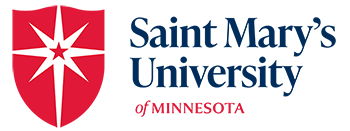Saint Mary's Newsroom / Campus Notes
Winona Campus Newsletter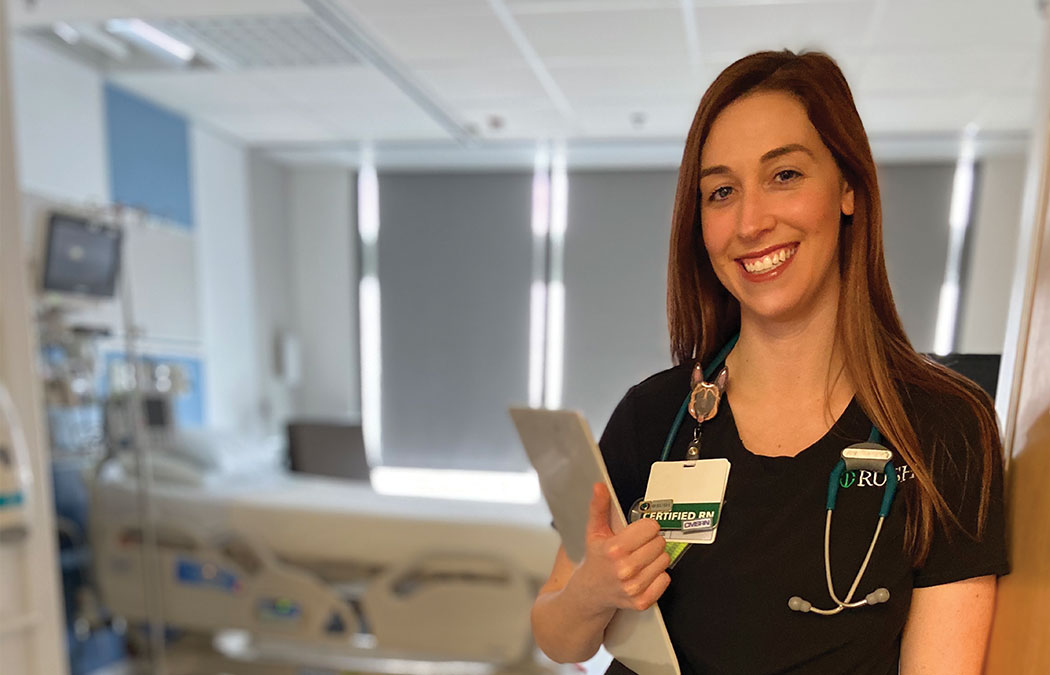
Heroes on the front lines – Colleen Joyce ’10 and Joe Haynes ’09 battle COVID-19 in Chicago
Colleen Joyce ’10 and her husband Joe Haynes ’09 say they wonder regularly which one of them will contract COVID-19 first.
They know, deep down, the question is ultimately more of a “when” than an “if.”
Joyce, an RN2 who works at Rush University Medical Center in downtown Chicago, and Haynes, a fire fighter with the Chicago Fire Department, are on the front lines of the pandemic, and frequently come face-to-face with the highly infectious disease.
“Every time we get out of the fire truck, we never know what we’re about to walk into,” Haynes said.
“It’s very worrisome. I come home to her and she comes home to me, and we work in the fields most affected by it. It’s always in the forefront of our thoughts. But it’s the job we signed up for. We know that we’ve got a job to do, and we try to do it the best we can and stay optimistic and hope it ends as quickly as possible.”
“We’re both taking extra precautions,” Joyce added. “We wash our hands a thousand times a day. I always wear a mask. I don’t think there’s such a thing as too many precautions. Neither of us can go to work if either of us gets it. And we don’t want to stay home; we want to be out there.”
The couple, who married about a year ago, met more than 11 years ago as undergraduate students on Saint Mary’s Winona Campus. They share an obvious a affinity for Chicago, for their two dogs, for (the late and great) Father Andrew Fabian of the Philosophy Department, for their alma mater, and for helping others.
Joyce majored in biology, knowing from her days of being a nanny that she wanted to work in the medical field; Haynes majored in English, went into the military, and became a prosecutor for the city of Chicago before joining the fire department nearly a year ago.
“I knew in college that I wanted to go into public service,” he said. “I knew as a firefighter I would also be able to still practice law and would be able to help two-fold. I joined the re department just in time for this national crisis, so I’m able to put my money where my mouth is.”
In mid March the couple completed a whirlwind tour of Europe, returning just two days before President Donald Trump suspended international travel because of safety concerns. Their jobs changed instantly.

Joe Haynes ’09 is a member of the Chicago Fire Department.
Haynes sees patients on the front end, responding to 911 calls and serving as a trained emergency medical technician. He and others on the truck respond to everything from gunshot wounds to emergency transports. In spring, he began seeing a lot of people who had COVID-19 symptoms who called 911 because they were having difficulty breathing.
If the patients are taken to Rush, there’s a possibility they will end up in Joyce’s COVID-19 unit. Joyce also serves as a clinical instructor for the hospital nursing program, and she recently transitioned into an interim director position — shortly before COVID-19 arrived in Chicago. “I got thrown into this madness,” she said.
When patients arrive via ambulance, after being admitted, they wait in her 32-bed unit (one of two the hospital established, in addition to multiple ICU COVID units). If they are negative, they are sent to another unit. If they are positive, they stay, unless they require intensive care.
“We monitor them very closely because it is a respiratory condition,” Joyce said. “We have a really good team on my unit who really took this on and has been very resilient. I feel like we’re learning from each patient. I’m so proud of how my staff has responded. It makes me proud to be a nurse and to work with them.”
Though days are long and draining — and having to quarantine themselves from the family they love has been an added emotional strain — the two find ways to remain positive. For Joyce, it’s about watching patients recover (like one patient who went back and forth from her unit to the ICU twice but is now home quarantining and doing well). “Seeing so many people recover gives me hope that we’re taking the right steps and going in the right direction,” she said.
She also described the overwhelming support Chicagoland businesses have shown her and other healthcare workers — by providing food, gift cards, and other gestures — as amazing.
For Haynes, it’s about how everyone has put aside their differences to get through this crisis together. “It’s lending perspective,” he said. “In this political climate, people are putting their differences aside. We’re all in this together, and we’re trying to get through this together, and that’s a bright spot for me.”
And, they enjoy coming home to each other and their two dogs, Lucy and Layla. “They are so excited when I walk in the door they make me forget about what I see every day,” Joyce said.
“They’re the best therapy.” They also give thanks for the technological advancements that allow them to connect virtually with friends and family, including the supportive friends they made at Saint Mary’s.
“My years at Saint Mary’s with Colleen were the best years of my life so far,” Haynes said. “We’ve made lifelong friendships, we had inspirational teachers, and when that day comes, we’ll encourage our children to attend Saint Mary’s.”
Photo caption: Colleen Joyce ’10 at Rush University Medical Center in Chicago.
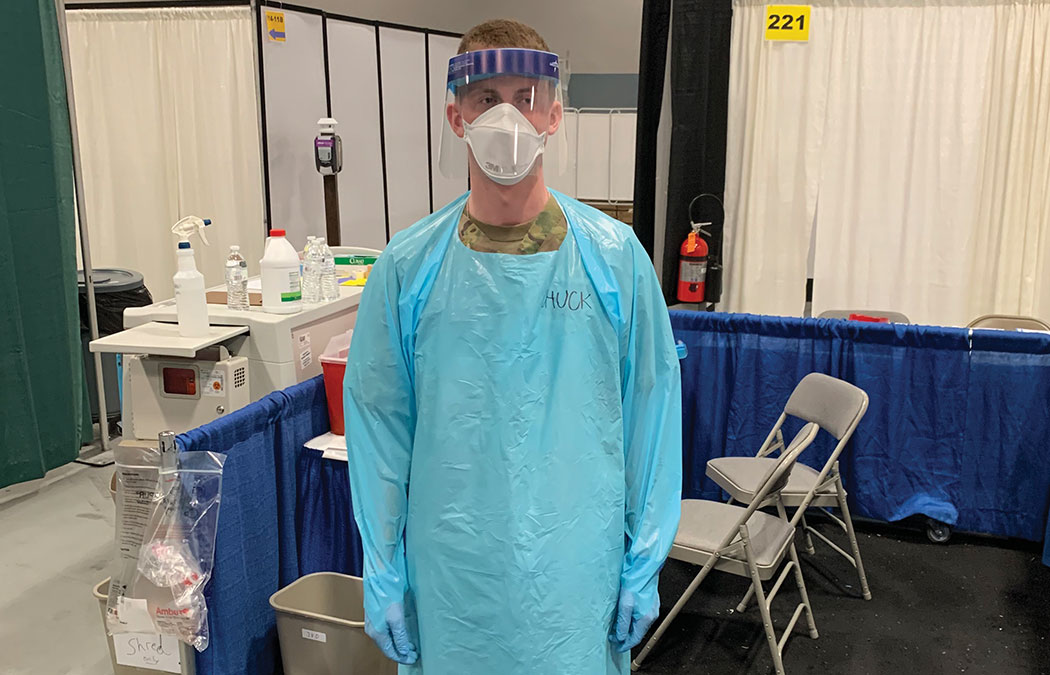
Heroes on the front lines – Charles Thibault ’21 was stationed in pandemic epicenter
As an Army Reserve medic, Sgt. Chuck Thibault ’21 is trained for trauma situations in battle, things such as gunshots and explosions.
He never dreamed he’d be working 12-hour shifts battling the coronavirus in the epicenter of this pandemic. But when he describes his work, which can be tiring and challenging, the words he chooses instead are rewarding and meaningful.
The junior criminal justice major from Shoreview, Minn., joined the Army Reserve nearly three years ago out of a desire to help others and a love for his country.
This spring he joined the more than 900 service members who were mobilized to combat the pandemic. In April, he and others in the 807th MC (DS) COVID-19 Army Reserve medical response team arrived in Edison, N.J., to work at a convention center converted into a make-shift hospital.
Thibault worked the night shift, where he helped to treat COVID-19 positive patients who were transferred in from other area hospitals.
The facility, he explained, was established to provide overflow care, take some strain off local hospitals, and provide needed relief for area medical personnel. Sgt. Thibault said he and other medical staff watched their patient numbers increase quickly. He estimated he personally saw about 20-30 patients each day, many of whom only spoke Spanish.
“I’ve taken many years of Spanish, and luckily I paid attention in class,” he said.
“I was able to ask them if they had pain or if they would like anything. I could tell them I was going to take their temperature. That was all really helpful because I would have been scared if I were them.
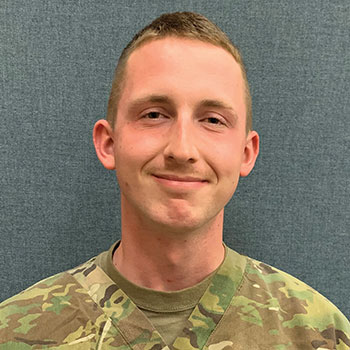
Sgt. Chuck Thibault ’21
“First they got sick with this virus, and when they came to our facility, everyone was all dressed up in personal protective equipment (PPE) so they couldn’t really see our faces. We tried to be friendly with them and put them at ease and conversed with them to get them as comfortable as we could.”
Located just 45 minutes from downtown New York City, Sgt. Thibault said he knew he was working in the epicenter of the pandemic. As he’s young and healthy, he worried less for his own personal safety than for those he worked with.
At the start of his shift, he carefully suited up in his PPE. Should he need to use the restroom or get a drink, he had to carefully remove his PPE, sanitize, and wash, and then dress in new PPE before re-entering.
Patients transferred to his facility were typically on oxygen but were relatively stable. “We gave them medications and tried to wean them off of oxygen,” he said. “They didn’t need to be in the ICU, but they weren’t ready to go home yet either. Our goal was to get them stable and healthy and then discharge them.
“It was a good feeling to get people out of there. You knew you were making a difference. The best part was knowing you were there helping people in an area where they really needed it, so it was very rewarding.”
Sgt. Thibault said he’s grateful to Saint Mary’s for allowing him to take a leave of absence and still complete his studies. And he was grateful for being able to virtually talk to friends and family back home. “I’m not really one to get down easily,” he said. “I knew it would be worse if we weren’t there, so it was easier to put it all into perspective. Someone had to be here, and I’m glad it was me and the others I worked with.”
It was difficult, he admitted, to not know how long he would be stationed so far from home. “The unknown can be daunting, and the whole situation was and is unknown,” he said. “I knew there were people back home doing well, and I know that this will all be over eventually. There’s light at the end of the tunnel.”
Thibault ’21 is trained for trauma situations in battle, things such as gunshots and explosions.
“It was a good feeling to get people out of there. You knew you were making a difference. The best part was knowing you were there helping people in an area where they really needed it, so it was very rewarding.”
Sgt. Thibault said he’s grateful to Saint Mary’s for allowing him to take a leave of absence and still complete his studies. And he was grateful for being able to virtually talk to friends and family back home. “I’m not really one to get down easily,” he said. “I knew it would be worse if we weren’t there, so it was easier to put it all into perspective. Someone had to be here, and I’m glad it was me and the others I worked with.”
It was difficult, he admitted, to not know how long he would be stationed so far from home. “The unknown can be daunting, and the whole situation was and is unknown,” he said. “I knew there were people back home doing well, and I know that this will all be over eventually. There’s light at the end of the tunnel.”
Photo caption: Chuck Thibault ’21 at work in a make-shift hospital in New Jersey.
Dashboard with COVID-19 statistics now live
To help answer questions and show transparency in how COVID-19 is affecting our university, the Marketing and Communication Office has created a dashboard on smumn.edu/coviddashboard. This dashboard currently details positive COVID-19 tests for the week of Aug. 17. Additional students have been tested this week but results are not yet known. Moving forward, numbers will be updated around 9 a.m. each weekday morning.

Mary Jane Melendez of General Mills to be honored during Saint Mary’s Hendrickson Forum
Annual public forum switches to free online format
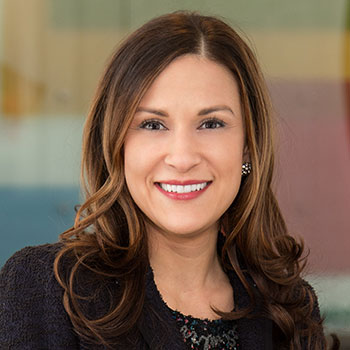
Mary Jane Melendez
MINNEAPOLIS, Minn. — Saint Mary’s University of Minnesota will honor Mary Jane Melendez, chief sustainability and social impact officer for General Mills and president of the General Mills Foundation, with the 2020 Hendrickson Medal for Ethical Leadership at this year’s virtual Hendrickson Forum, scheduled for noon Tuesday, Nov. 10.
The event, “Blueprint: How Artificial Intelligence Can Build on the Evolutionary Origins of a Good Society,” is presented by Saint Mary’s Hendrickson Institute for Ethical Leadership and will feature a keynote address by Nicholas A. Christakis, M.D., Ph.D., M.P.H., director of Yale University’s Human Nature Lab and co-director of the Yale Institute for Network Science. Dr. Christakis will address how certain kinds of social artificial intelligence (AI) might best be used to enhance our society.
“We are thrilled to honor Mary Jane as our Hendrickson Medal recipient,” said Audrey Kintzi, Saint Mary’s vice president for advancement and communication, who leads the Hendrickson Forum. “Her important work is helping General Mills build stronger communities on a global scale.”
Melendez stewards the company’s sustainability and philanthropy efforts, working closely with supply chain, sourcing, the foundation and other key business leaders to develop, coordinate, and execute programs to achieve companywide targets. She is responsible for advancing collaboration to drive change by promoting environmentally and socially responsible practices across the entire chain, from farm to fork and beyond. Her role combines accountability for taking care of our planet and nourishing communities to amplify the impact of General Mills as a global force for good.
She also encourages others at General Mills to participate in various volunteer opportunities and serves on the board of the Saint Paul & Minnesota Community Foundation.
Recipients of the Hendrickson Medal for Ethical Leadership have made significant contributions to the Twin Cities community and exhibit ethical leadership that is globally oriented and innovative or creative; as well as citizenship that significantly improves the lives of others’ appreciation for diverse ideas and perspectives. Past medal recipients include Brad Hewitt of Thrivent Financial; Rhoda Olsen of Great Clips; Inge Thulin of 3M; Mary Brainerd of HealthPartners, and more.
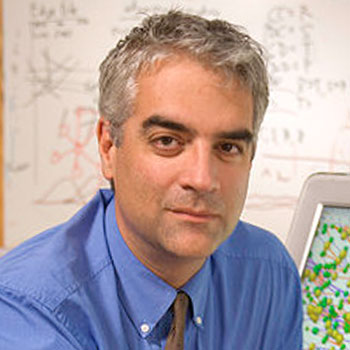
Nicholas A. Christakis
This year’s keynote speaker, Dr. Christakis, is named to TIME’s “100 Most Influential People in the World” and to Foreign Policy’s “Top 100 Global Thinkers.” A renowned physician and social scientist, he will help us more deeply — and optimistically — understand our society as well as our individual and collective behavior.
This year’s virtual event, originally scheduled as a luncheon this past spring, is now free and open to the public. The video will go live at smumn.edu/HendricksonForum at noon Tuesday, Nov. 10, but will be viewable for an extended period.
About the Hendrickson Institute for Ethical Leadership
The Hendrickson Institute for Ethical Leadership is an educational enterprise of Saint Mary’s University of Minnesota and serves as an educational and transformational resource to the community. Founded in 1994 and located in Minneapolis on the Twin Cities Campus of Saint Mary’s University of Minnesota, the institute serves both current and emerging leaders. It is an academic resource for Saint Mary’s University of Minnesota and the community, and a forum for exploration of ethical issues. As part of its mission, the institute provides programs that encourage and develop ethical, globally oriented leaders; offers integrative leadership models promotes practical, ethical principles; and infuses leaders with an appreciation of spirituality and free enterprise. For additional information, visit smumn.edu/HendricksonInstitute.
Saint Mary’s partners with Emsi on labor market analytics
WINONA, Minn. — Saint Mary’s University of Minnesota has partnered with Emsi, a labor market analytics firm, to propel online education initiatives forward, especially during the pandemic.
Through the partnership, Saint Mary’s will work with Emsi to further existing online program strategic plans, helping to ensure Saint Mary’s leadership is using up-to-date workforce data in decision-making. In particular, Emsi will provide Saint Mary’s with information on the skillsets employers in Minnesota (and around the nation) are seeking, to better understand how today’s students can be served in the current economy.
“Over the past few months, this global pandemic has exacted a tremendous toll on the people, families, and businesses in our communities. One challenge many of our students and their parents face on a day-to-day basis is that COVID-19 has fundamentally altered the U.S. economy. Many have lost or are in danger of losing their jobs or businesses,” said Andrea Carroll-Glover, vice provost for online strategy and programs. “Partnering with Emsi is just one of the many initiatives Saint Mary’s is pursuing to more effectively serve our students in crisis.”
As a Lasallian Catholic university, Saint Mary’s prepares students for ethical lives of service and leadership. Training students who are well-prepared for the workforce has long been a key part of Saint Mary’s vision, and the university has recently taken steps to reaffirm that commitment.
About Emsi
Emsi is a labor market analytics firm that has helped university leaders make data-driven decisions since 2006. More than 400 institutions nationwide rely on Emsi to better understand the needs of their local economy and position their students with the skills needed for successful careers post-graduation. Emsi maintains offices in Dallas, Texas, the United Kingdom, and a home office located in the rolling hills of Northern Idaho’s Palouse region. For more information, visit economicmodeling.com.

Princeton Review names Saint Mary’s University to ‘Best Midwestern’ category
Princeton Review has once again listed Saint Mary’s University of Minnesota in its “Best Midwestern” category within the “2021 Best Colleges: Region by Region” report.
Princeton Review evaluates 655 colleges they consider academically outstanding, as well as worth students’ consideration, in four regions of the country. These 655 colleges, 158 in the “Best Midwestern” category, constitute just 23% of the nation’s four-year colleges. In addition to academic excellence, Princeton Review weighs what students attending the schools reported about their campus experiences.
The future of business
Saint Mary’s knows the best way to prepare learners for today’s rapidly changing business world is to expand the way we view business education.
Today, preparing business students — graduate or undergraduate — extends far beyond classroom instruction.
At the undergraduate level, Saint Mary’s provides undergraduate students with both holistic preparation and hands-on learning to thoroughly prepare them for the business world of tomorrow. And, at the graduate level, Saint Mary’s is creating programming and individualized pathways to help adult learners get ahead and stay ahead in business — regardless of where they are in their careers.
It’s not just about adapting, it’s about being on the front lines of change, whether in experiential learning, technology trends, collaborative disciplines, or individualized pathways.
Undergraduate Business and Technology
Students in our School of Business and Technology receive the unique pairing of critical thinking skills and a broad liberal arts education, and they have the added benefit of emerging with a solid foundation of ethics and core values — so needed in today’s business climate. These students develop skills in all aspects of business: accounting, business intelligence and data analytics, entrepreneurship, finance, international business, management, marketing, and sport management.
Simultaneously, they integrate theory and practice through unique experiences like the Mayo Innovation Scholars program, immersive internships and co-ops with national and international businesses, the Kabara Institute for Entrepreneurial Leadership, and collaborative hands-on projects like working at ESPN’s X Games.
And, because the real world of business expands into other disciplines, we’re renovating a space for business and science students to learn and collaborate together to better solve today’s complex problems. The Adducci Science Center’s Hoffman and Brother Charles Halls, expected to be completed in fall 2021, will include a makerspace, sales training suite, nursing suite, collaborations space for external partners, and labs for finance and trading, business analytics, and science research.
Graduate Business and Technology
In 2019, Saint Mary’s MBA was recognized as the third largest in the state. Building on our reputation for innovation and excellence, we’ve developed a series of focused certificates built around our MBA and other master’s programs.
Through these new stackable credentials — called Saint Mary’s Accelerators — adult learners will be able to accelerate their careers, as well as their education.
These graduate certificate programs can stand alone, keeping adult learners up to speed on current knowledge and trends. The certificates can also stack together to form a full program, putting our adult learners ahead of the game should they want to earn a graduate degree in the future. Adult learners can couple them with our degree programs to customize their learning experiences and prepare them for the next steps in their careers.
All Saint Mary’s Business and Technology graduate programs are convenient, affordable, and known for both rigor and relevance.
As we position ourselves for growth, we are building additional business partnerships and creating more flexible academic opportunities. Saint Mary’s also plans to launch an accelerated bachelor’s completion into master’s program while building pathways between our campus locations in Winona and Rochester to our graduate programs. These programs will allow learners to achieve higher-level credentials in a shorter amount of time.
Michelle Wieser, Ph.D., dean of the School of Business and Technology, intends to make Saint Mary’s a destination school for business across all locations and modalities. It’s part of our strategic plan, but it’s who we’ve always been: innovators.
Find out more information about undergraduate programs and graduate programs or connect with our admissions offices.
Dr. Wieser tells us more about “The Future of Business” at Saint Mary’s University.
Tips for the new normal: social distancing and wearing masks
Social distancing and wearing masks have become our new normal. Here are two resources to help you as you adjust to these new protocols.
- This article from The Philadelphia Inquirer offers a few simple, yet creative, reminders of what 6 feet apart looks like.
- This poster, which you might also see around campus, offers helpful tips on how to properly wear and clean your mask.
For more tips and helpful information on COVID-19, visit smumn.edu/covidplanning.

Heroes on the front lines-Zacher’s work vital to COVID testing and treating at Mayo Clinic
Jeremy Zacher M’19 doesn’t ever see or interact with patients at Mayo Clinic, yet his work is vital to the frontline heroes testing and treating COVID-19 patients.
As an education coordinator and instructor in Laboratory Medicine and Pathology, Zacher and his team support departmental education and all of the educators for more than 60 laboratories at Mayo Clinic. His personal areas of focus are online training and leadership development.
The advance of COVID-19 has dramatically shifted his work plan priorities. “Though education is obviously still important, we have shifted into a support mode to help with technology issues, work with assignments for online training, and assisting staff with working more efficiently and effectively,” he said. “Each day is a little different with the challenges we tackle.”
One of those challenges has been training lab workers doing COVID-19 lab testing.
“Much of what I do deals with online training and education, so this has been all about supporting our staff and helping them adapt quickly,” he said.
“We have many laboratory staff members who are redeployed to help with the COVID-19 testing, so they need to be trained quickly so that they can contribute as soon as possible. My work as of late has included creating online training, videos, and quick reference guides for staff to use in their training.”
Though much of the Mayo Clinic laboratory staff still needs to be on site, many are now working from home for the first time, so Zacher and his team are there to train and answer questions.
“Many of those working from home have never had to deal with that sort of challenge before, so we are supporting them through the change,” Zacher said. “Part of that includes teaching them about the technologies, but also we try to support the well-being of the employees. We work with a variety of people, some of whom haven’t previously had to do meetings online. It’s about getting people more comfortable with using the technology, providing them with resources to work from home, and helping them feel good about what they’re doing on a daily basis.”
Zacher is finding multiple ways to directly apply what he learned in Saint Mary’s M.Ed. in Learning Design and Technology program. He graduated in 2019.
He admits getting his master’s degree was something he’d always wanted to do but had put off for quite some time, telling himself his workload and his family life would make it too difficult. But after working at Mayo Clinic for about 15 years, he decided the time was right and that a master’s degree would open up the door to more opportunities.
“I looked at a variety of programs, and the LDT program stood out because of how it fit with both my work and my own interests. Because education and technology have really been passions of mine, it seemed like a great fit. I was able to modify and adapt what I was learning directly to the work I was doing, which made
it seem less like another task to manage and more like a way of enhancing the things I was already doing. One top of that, the support I got throughout the process from my classmates and professors was outstanding.”
Zacher said the experience continues to benefit him in his career; for starters, after successfully balancing school, work, and family life, he feels confident in his ability to manage multiple projects and deadlines all at once.
“Much of what I do for the department is to help our educators and trainers become better at what they do, so it was great to be able to share what I learned with my colleagues at the same time that I was improving myself and developing into a more effective leader for our laboratories and for Mayo Clinic.”
Although Zacher said it’s both humbling and exciting to be a part of the COVID-19 fight, he doesn’t consider himself a hero. “We have so many great researchers, technologists, specialists, and lab assistants who are on the front lines, collecting samples, testing specimens, and searching for answers, and I see them as the real heroes of all of this because of how vitally important their work is to keeping everyone safe and healthy.
“Mayo Clinic’s primary value is that ‘the needs of the patient come first’,” he said. “For those of us in roles that don’t see patients, sometimes it’s hard to truly visualize what that means, but in today’s world, it’s very apparent to see the impact we are having on the lives of so many people. I am just happy to be able to do my part and contribute where I can.”

Heroes on the front lines – Schreder helps Haitians construct masks
Ellen Schreder’s voice cracks emotionally when she speaks of her Haitian friends and what she describes as their “infectious hope and joy.”
In the wake of the COVID-19 pandemic, she constantly fears for their safety.
“They’re being told to wash their hands, but 80 percent of them don’t have access to running water,” she said.
“They’re being told to socially distance but they can’t. Their food is purchased in open markets … where they are shoulder to shoulder with each other, and they live in close proximity to one another.”
And if they do get sick, she adds, there’s no access to medical care.
Schreder said she read there are an estimated 60 ventilators in all of Haiti (which has an estimated population of 11.5 million). In truth, she discovered there are maybe 20 functioning ventilators, and medical personnel don’t know how to properly use them.
“They’re dying in their homes and not being counted because nobody knows,” she said.
“We’ll never know.”
Schreder, who is a partner at a Minneapolis law firm, first fell in love with the people of Haiti when she visited the country with her daughter on a mission trip about 15 years ago. In 2014, she and colleague Dr. Leslee Jaeger established a way to support Haitians in supporting themselves through Days for Girls and Helping Haiti Work.
It began with teaching Haitians to construct reusable menstrual products but, in the wake of the pandemic, has switched to manufacturing cloth masks.
Schreder had discovered that without access or funding to purchase proper sanitary products, girls in Haiti and other Third World countries were often forced to miss school for a week every month. Ultimately, she said, many dropped out of school.
Schreder and Jaeger began helping Haitian women develop valuable sewing skills, as well as a business plan for constructing and marketing sustainable feminine hygiene solutions. From their newfound income, the Haitian workers could now support their families, and countless girls were given the supplies and confidence they needed to stay in school. Schreder and Jaeger lead the Days for Girls Enterprise Team in Haiti (the only one in existence in Haiti).
When Haitian nonprofits began seeing a large demand for cloth masks this spring, they switched priorities. Haitian workers had constructed upwards of 6,000 masks by April 21.
At $2 each, the seamstresses are taking home about 50 cents per mask, which is greatly helping their families.
The orders keep coming in, and like here in the U.S., many businesses are closed, and material is hard to come by.
Another outcome of the pandemic has been an extreme rise in the price of food. Schreder recently raised $3,600 from family and friends, which was used to purchase large quantities of food for Haitian families. Even with cash, because of the current food scarcity in Haiti, it was difficult to find what they needed.
Too often, Schreder said, Haitians are forgotten.
Sometimes, she explained, visitors from more affluent countries visit Haiti on a volunteer mission. They come bearing gifts and they stay a few days, maybe a week, and help with building projects or other chores.
But when they leave, they never return.
Schreder said back in 2014 she had visited Haiti for about a week to teach women how to sew. She had discovered that her team of local sewers were very skilled but that they had rushed to get through the first round of production and earn as much as they could. They assumed she — like so many before her — would never return. On the first of many return trips, Schreder was greeted by the surprised exclamation, “Miss Ellen; you came back!”
“No one is ever as happy to see me as my Haitian friends,” she said.
Schreder looks forward to her return visits, which are now three or four times a year. In September, she led a group that included other Saint Mary’s alumnae Mary (Hennessy) Pawlowski ’82 and Cindy (Chamberlain) Budd ’82. Schreder attended Saint Mary’s for two years, between 1980 and 1982, and she made lifelong friends during that time. She was excited to introduce her U.S. friends to her Haiti friends.
“I can tell people about this all day long every day and unless you go there and see it, and touch it, and smell it, and feel it … It gets me choked up just talking about it. I look at them and I see they have nothing and they are so happy,” she said.
“And then I come back here and look at all that we have, and people just don’t get it. It’s life altering. I have a lot to learn from them.”
Photo caption: Ellen Schreder with some of her Haitian seamstresses.
Welcome back to campus
Hello Cardinals,
This newsletter is where all valuable COVID-19-related and move-in information is located. Please encourage your peers to read this newsletter. New students are busy moving into their residence halls. It’s wonderful to once again hear the sound of laughter on campus. It’s also reassuring to see everyone is adjusting to and adhering to our social distancing guidelines.
As a university, we are ready. We implemented guidelines, planned, planned even more, educated our community, rearranged our classrooms and meeting spaces, and purchased precautionary items — all in accordance to guidelines from the Centers for Disease Control and Prevention (CDC) and Minnesota Department of Health (MDH). You are now in the driver’s seat; it is up to you to adhere to these guidelines to keep our community safe and to keep everyone on campus. Your actions during these first couple of weeks (but really all semester) could mean the difference between staying in Winona or needing to switch to online learning. We are depending on your partnership.
We’ve been monitoring situations at other colleges and universities that have needed to pivot to online learning within two weeks of having students on campus. Let’s break this trend. I know we can be better, and I have faith in you. We know the value of an in-person education, and we know your desire to be on campus.
Let’s make this a great semester.

Tim Gossen, Ed.D.
Vice President for Student Affairs
Campus updates and reminders
A few updates and reminders:
- Keep reviewing smumn.edu/covidplanning as we continue to update and add items frequently. We’ve added helpful videos from the CDC this week.
- As you are packing, remember to review one last time the “what to bring with you” list including: two masks, liquid hand soap, personal hand sanitizer, disinfectant wipes, a thermometer, a bottle to refill sanitizer, a reusable water bottle, tissues, and a bag for your mask.
- Although we have sanitation stations set up in common areas, having your own sanitizing supplies for your own room will be very helpful.
- If you have a maintenance request in your residence hall room, please contact the Residence Life staff and they will submit a request for you. When the staff member comes to your room to fix the item, you will be asked to temporarily leave until they are finished with the job for safety reasons.
- Please remember to wear your masks properly over your nose and mouth pretty much any time you are away from your sleeping room and not alone.
- According to MDH, surface transmission is low risk, but we should still clean surfaces as much as possible. Wipe areas before and after you eat, work out, attend class, or study.
- In the classroom, do not move chairs around and adhere to the 6-foot rule at all times. Faculty will not be moving around the classroom as much so they can also adhere to this rule.
- Please make sure you are cleaning your masks regularly. Cleaning mask guidelines are posted throughout campus.
- We are developing a COVID-19 dashboard for the university website to show weekly numbers of positive COVID-19 cases on our campuses, as well as how many individuals are being tested. Once completed, we will share this link with the Saint Mary’s community. This will help keep everyone updated on how we are doing.
- While in food service, please be mindful of the following:
- Approximately 100 students can sit in the main dining room.
- Other spaces available are the plaza, game room, gym lobby, Toner Student Center lounge, President’s Room, and your residence hall.
- Do not bring your own containers for food or drink; use what is provided.
- Take only the amount of food you will eat and make sure you are taking enough, as seconds will not be an option at the moment.
- Use hand sanitizer when you come into the main dining room, Cardinal Coffee, or Cardinal Club.
- Stand on the red floor decals (either the 6-foot social distance decal or the arrow).
- Each residential student should read the letters — which reference a number of COVID-19-related guidelines — that have been placed in your sleeping rooms. Commuter students will also get this letter shortly.
- Please continue to be flexible and patient. Things continue to change quickly, and we do not always have the answers to every question. But I can assure you we are working hard and will respond to you in a timely manner.
- I encourage each of you to politely remind your peers, faculty, and staff to adhere to social distancing and COVID-19 guidelines. It is important we all take responsibility for keeping our education in person this semester.
Video message from Student Senate president
Kendall Archer ’21, Student Senate president, shares a special welcome back message.
